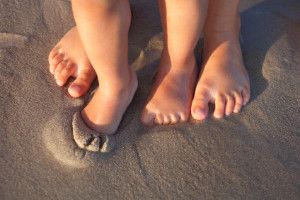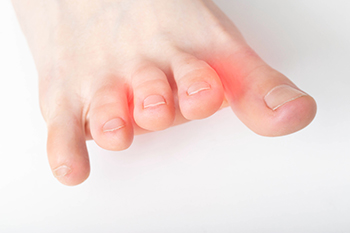Middlefield (860) 349-8500
Wallingford (203) 294-4977
Middlefield (860) 349-8500
Wallingford (203) 294-4977

Research has shown there may be a connection of walking barefoot and increased cognitive abilities. When children walk barefoot, they may become more aware of different textures that are walked on, which may contribute to understanding spatial awareness. There are numerous nerves in the feet, and when shoes are frequently eliminated, the opportunity to grow new neural connections may increase. The skin on the bottom of the feet will become tougher, and walking in environments with grass or sand may help to increase a sense of freedom. Toxic stress may be decreased, and walking in these types of environments may help to regulate the nervous system. Studies have shown that babies feet are preferred receptors, and emotions may possibly be regulated when children can walk barefoot while outside. If you would like more information about the benefits of having your child walk barefoot, please speak with a podiatrist who can address any concerns you may have.
Making sure that your children maintain good foot health is very important as they grow. If you have any questions, contact Dr. Gordon Fosdick of Affiliated Foot Care Center. Our doctor can provide the care you need to keep you pain-free and on your feet.
Keeping Children's Feet Healthy
Having healthy feet during childhood can help prevent medical problems later in life, namely in the back and legs. As children grow, their feet require different types of care. Here are some things to consider...
Although babies do not walk yet, it is still very important to take care of their feet.
Avoid putting tight shoes or socks on his or her feet.
Allow the baby to stretch and kick his or her feet to feel comfortable.
As a toddler, kids are now on the move and begin to develop differently. At this age, toddlers are getting a feel for walking, so don’t be alarmed if your toddler is unsteady or ‘walks funny’.
As your child gets older, it is important to teach them how to take care of their feet.
Show them proper hygiene to prevent infections such as fungus.
Be watchful for any pain or injury.
Have all injuries checked by a doctor as soon as possible.
Comfortable, protective shoes should always be worn, especially at play.
If you have any questions please feel free to contact our offices located in Middlefield and Wallingford, CT . We offer the newest diagnostic and treatment technologies for all your foot and ankle needs.

Our feet provide us with the mobility to walk, run, and complete daily tasks. It is important to take proper steps in taking care of our feet, and this may help in preventing foot pain. Despite this information, research has indicated that approximately one out of three people who are over 65 years old will have foot pain. Heel pain is common, and may be a sign of plantar fasciitis. This can happen when the plantar fascia becomes inflamed from wearing shoes that do not fit correctly. Athlete’s foot can be uncomfortable and unsightly. This can develop from a fungal infection, and it may be prevented by wearing appropriate shoes while frequenting public swimming pools and locker rooms. A pain or ache in the back of the leg may indicate an Achilles tendon injury has developed, and it may come from increasing speed or distance too quickly while running. Any type of foot pain can wreak havoc on the day’s activities, and it is advised that you speak to a podiatrist who can determine what the cause is and treat your foot pain accordingly.
Foot Pain
Foot pain can be extremely painful and debilitating. If you have a foot pain, consult with Dr. Gordon Fosdick from Affiliated Foot Care Center. Our doctor will assess your condition and provide you with quality foot and ankle treatment.
Causes
Foot pain is a very broad condition that could be caused by one or more ailments. The most common include:
Diagnosis
To figure out the cause of foot pain, podiatrists utilize several different methods. This can range from simple visual inspections and sensation tests to X-rays and MRI scans. Prior medical history, family medical history, and any recent physical traumatic events will all be taken into consideration for a proper diagnosis.
Treatment
Treatment depends upon the cause of the foot pain. Whether it is resting, staying off the foot, or having surgery; podiatrists have a number of treatment options available for foot pain.
If you have any questions, please feel free to contact our offices located in Middlefield and Wallingford, CT . We offer the newest diagnostic and treatment technologies for all your foot care needs.

Toenail fungus can become painful and turn into an infection. This condition usually starts as white or yellowish spots on the tips of the toenails, eventually causing unsightly thickening, discoloration, and crumbling. Anyone can get toenail fungus, but some populations are more at risk than others. For example, those over 60 are more apt to suffer from this condition because as they age, their nails become drier, more brittle and cracked and fungi can sneak through. Those who sweat more than usual have a prime breeding ground for toenail fungus. Wearing tight shoes and thick socks can make feet sweat more and invite fungus to grow inside. If one has had toenail fungus before, there is a high likelihood of getting it again. Walking barefoot in humid and wet public places, such as swimming pools or locker rooms, can cause toenail fungus to spread. If you have signs of toenail fungus, seek the counsel of a podiatrist as soon as possible so that the condition will not worsen or spread to others.
For more information about treatment, contact Dr. Gordon Fosdick of Affiliated Foot Care Center. Our doctor can provide the care you need to keep you pain-free and on your feet.
Toenail Fungus Treatment
Toenail fungus is a condition that affects many people and can be especially hard to get rid of. Fortunately, there are several methods to go about treating and avoiding it.
Antifungals & Deterrence
Oral antifungal medicine has been shown to be effective in many cases. It is important to consult with a podiatrist to determine the proper regiment for you, or potentially explore other options.
Applying foot powder on the feet and shoes helps keep the feet free of moisture and sweat.
Sandals or open toed shoes – Wearing these will allow air movement and help keep feet dry. They also expose your feet to light, which fungus cannot tolerate. Socks with moisture wicking material also help as well.
If you have any questions please feel free to contact our offices located in Middlefield and Wallingford, CT . We offer the newest diagnostic tools and technology to treat your foot and ankle needs.

Ankle pain is common and it often hinders the ability to complete daily activities. It can throw a wrench in trying to walk from point A to point B. Performing specific stretches may help to ease the pain. It is beneficial to warm up the muscles before stretching them. This can be done by cycling, slowly walking, or by using an elliptical. An effective stretch can be done while sitting in a chair with your legs crossed. When the ankle is over the opposite knee, rotate the ankle clockwise. After repeating on the other leg, it is time for the next stretch. While the ankle is in the same position, it can feel good to gently pull the ankle toward you, and then repeat on the other leg. The heels and ankles can become stronger when heel and toe raises are practiced. This is done by sitting in the same chair with both feet on the ground, followed by lifting the toes first, then the heels. There are several additional stretches that can help to relieve ankle pain. If you would like more information about this, please consult with a podiatrist.
Ankle pain can have many different causes and the pain may potentially be serious. If you have ankle pain, consult with Dr. Gordon Fosdick from Affiliated Foot Care Center. Our doctor will assess your condition and provide you with quality foot and ankle treatment.
Ankle pain is any condition that causes pain in the ankle. Due to the fact that the ankle consists of tendons, muscles, bones, and ligaments, ankle pain can come from a number of different conditions.
Causes
The most common causes of ankle pain include:
Symptoms
Symptoms of ankle injury vary based upon the condition. Pain may include general pain and discomfort, swelling, aching, redness, bruising, burning or stabbing sensations, and/or loss of sensation.
Diagnosis
Due to the wide variety of potential causes of ankle pain, podiatrists will utilize a number of different methods to properly diagnose ankle pain. This can include asking for personal and family medical histories and of any recent injuries. Further diagnosis may include sensation tests, a physical examination, and potentially x-rays or other imaging tests.
Treatment
Just as the range of causes varies widely, so do treatments. Some more common treatments are rest, ice packs, keeping pressure off the foot, orthotics and braces, medication for inflammation and pain, and surgery.
If you have any questions, please feel free to contact our offices located in Middlefield and Wallingford, CT . We offer the newest diagnostic and treatment technologies for all your foot care needs.

One of the most common things noticed by pregnant women is their swollen feet and ankles. It is a normal occurrence during pregnancy because of the excess fluid that the body produces for the growing fetus. The swelling may worsen as the due date approaches and may cause extreme discomfort during warmer weather. There are effective methods that can be implemented to help minimize existing swelling during pregnancy. These can include elevating the feet as often as possible, wearing support stockings during the day, and avoiding standing for extended periods. Additionally, it may help to lie on the left side when sleeping as well as drink plenty of water daily to help release some of the fluid. Some women find comfort in swimming or standing in a pool and exercising regularly. If you are pregnant and have extremely swollen feet, please consult with a podiatrist who can provide effective relief methods.
Pregnant women with swollen feet can be treated with a variety of different methods that are readily available. For more information about other cures for swollen feet during pregnancy, consult with Dr. Gordon Fosdick from Affiliated Foot Care Center. Our doctor will attend to all of your foot and ankle needs.
What Foot Problems Can Arise During Pregnancy?
One problem that can occur is overpronation, which occurs when the arch of the foot flattens and tends to roll inward. This can cause pain and discomfort in your heels while you’re walking or even just standing up, trying to support your baby.
Another problem is edema, or swelling in the extremities. This often affects the feet during pregnancy but tends to occur in the later stages.
How Can I Keep My Feet Healthy During Pregnancy?
If you have any questions please feel free to contact our offices located in Middlefield and Wallingford, CT . We offer the newest diagnostic and treatment technologies for all your foot and ankle needs.

The foot condition that is known as Morton’s neuroma can cause debilitating pain and discomfort. This is an ailment that affects the nerve which lies between the third and fourth toes, causing it to become thickened and irritated. It is a condition that can be common among women who frequently wear high heels. These types of shoes generally have little area in the toe box, prohibiting the toes to move freely. Patients who have Morton’s neuroma often liken the pain in their feet to having a pebble or marble in their shoe. Additionally, there may be a burning sensation in the ball of the foot, as a result of extreme inflammation. There may be existing conditions affecting the feet which can lead to getting this condition, including bunions, flat feet, or high arches. A proper diagnosis consists of pressing on specific areas of the affected foot, and an X-ray may be taken to rule out fractures or arthritis. The discomfort from this ailment is difficult to ignore, and if you are afflicted with this type of pain, please schedule an appointment with a podiatrist as quickly as possible who can help you to find relief.
Morton’s neuroma is a very uncomfortable condition to live with. If you think you have Morton’s neuroma, contact Dr. Gordon Fosdick of Affiliated Foot Care Center. Our doctor will attend to all of your foot care needs and answer any of your related questions.
Morton’s Neuroma
Morton's neuroma is a painful foot condition that commonly affects the areas between the second and third or third and fourth toe, although other areas of the foot are also susceptible. Morton’s neuroma is caused by an inflamed nerve in the foot that is being squeezed and aggravated by surrounding bones.
What Increases the Chances of Having Morton’s Neuroma?
Morton’s neuroma is a very treatable condition. Orthotics and shoe inserts can often be used to alleviate the pain on the forefront of the feet. In more severe cases, corticosteroids can also be prescribed. In order to figure out the best treatment for your neuroma, it’s recommended to seek the care of a podiatrist who can diagnose your condition and provide different treatment options.
If you have any questions, please feel free to contact our offices located in Middlefield and Wallingford, CT . We offer the newest diagnostic and treatment technologies for all your foot care needs.

The foot is made up of three parts, the forefoot consisting of the toes, the midfoot made up of the small navicular, cuneiform, and cuboid bones, and the hindfoot consisting of the lower ankle and heel. The Lisfranc joint is at the connection of the forefoot and midfoot. An injury to this joint can involve a dislocation, where there is a separation of the normal joint alignment between the forefoot and the midfoot, or a broken bone, usually in the midfoot. This typically happens when the foot is in a downward, pointed position and someone lands on top of it. It can also occur from an auto accident, an awkward step on an uneven surface, or a fall. If you have pain or swelling in the midfoot and it hurts to walk or stand, see a podiatrist for a proper diagnosis and treatment plan ranging from a walking cast to surgery depending on severity.
A broken foot requires immediate medical attention and treatment. If you need your feet checked, contact Dr. Gordon Fosdick from Affiliated Foot Care Center. Our doctor can provide the care you need to keep you pain-free and on your feet.
Broken Foot Causes, Symptoms, and Treatment
A broken foot is caused by one of the bones in the foot typically breaking when bended, crushed, or stretched beyond its natural capabilities. Usually the location of the fracture indicates how the break occurred, whether it was through an object, fall, or any other type of injury.
Common Symptoms of Broken Feet:
Those that suspect they have a broken foot shoot seek urgent medical attention where a medical professional could diagnose the severity.
Treatment for broken bones varies depending on the cause, severity and location. Some will require the use of splints, casts or crutches while others could even involve surgery to repair the broken bones. Personal care includes the use of ice and keeping the foot stabilized and elevated.
If you have any questions please feel free to contact our offices located in Middlefield and Wallingford, CT . We offer the newest diagnostic and treatment technologies for all your foot and ankle needs.

Weightlifting can be an exciting, motivating sport to participate in. It can also result in a risk of injury to the feet. Lifting heavy weights while doing squats or lunges can put significant stress on the feet. Overtraining, not taking enough time to recover between weightlifting sessions, and wearing improper footwear for the sport are among the things that can impact the pressure put on your body and feet. The most common injuries in weightlifting that can cause foot pain are plantar fasciitis, stress fractures, and muscle strains. Treatment varies by injury, but rest may help alleviate foot pain. If your pain does not go away or worsens, contact a podiatrist for a diagnosis and treatment so that you can get back to training as soon as possible.
Sports related foot and ankle injuries require proper treatment before players can go back to their regular routines. For more information, contact Dr. Gordon Fosdick of Affiliated Foot Care Center. Our doctor can provide the care you need to keep you pain-free and on your feet.
Sports Related Foot and Ankle Injuries
Foot and ankle injuries are a common occurrence when it comes to athletes of any sport. While many athletes dismiss the initial aches and pains, the truth is that ignoring potential foot and ankle injuries can lead to serious problems. As athletes continue to place pressure and strain the area further, a mild injury can turn into something as serious as a rupture and may lead to a permanent disability. There are many factors that contribute to sports related foot and ankle injuries, which include failure to warm up properly, not providing support or wearing bad footwear. Common injuries and conditions athletes face, including:
Sports related injuries are commonly treated using the RICE method. This includes rest, applying ice to the injured area, compression and elevating the ankle. More serious sprains and injuries may require surgery, which could include arthroscopic and reconstructive surgery. Rehabilitation and therapy may also be required in order to get any recovering athlete to become fully functional again. Any unusual aches and pains an athlete sustains must be evaluated by a licensed, reputable medical professional.
If you have any questions please feel free to contact our offices located in Middlefield and Wallingford, CT . We offer the newest diagnostic and treatment technologies for all your foot and ankle needs.

Having flat feet is a foot condition that affects approximately 8 million people in the country. It is noticeable by the absence of an arch in the foot, and it can cause some people pain and discomfort. The majority of babies are born with flat feet, and the arch generally develops fully in the teenage years. Some adults will never have an arch, and this may affect certain parts of their lives. A common concern that is held by people who have flat feet and are interested in joining the military consists of being qualified for certain branches of service. In the past, military enlistment was not permitted for people with flat feet, but that policy has recently been changed. People who have this condition are allowed to enter the military, providing there are no obvious symptoms. However, if there is foot pain or swelling from flat feet, the interested person will be barred from enlisting. If you have questions about flat feet and how it contributes to enlisting in the military, please contact a podiatrist, who can answer any questions and concerns you may have.
Flatfoot is a condition many people suffer from. If you have flat feet, contact Dr. Gordon Fosdick from Affiliated Foot Care Center. Our doctor will treat your foot and ankle needs.
What Are Flat Feet?
Flatfoot is a condition in which the arch of the foot is depressed and the sole of the foot is almost completely in contact with the ground. About 20-30% of the population generally has flat feet because their arches never formed during growth.
Conditions & Problems:
Having flat feet makes it difficult to run or walk because of the stress placed on the ankles.
Alignment – The general alignment of your legs can be disrupted, because the ankles move inward which can cause major discomfort.
Knees – If you have complications with your knees, flat feet can be a contributor to arthritis in that area.
Symptoms
Treatment
If you are experiencing pain and stress on the foot you may weaken the posterior tibial tendon, which runs around the inside of the ankle.
If you have any questions please feel free to contact our offices located in Middlefield and Wallingford, CT . We offer the newest diagnostic and treatment technologies for all your foot and ankle needs.